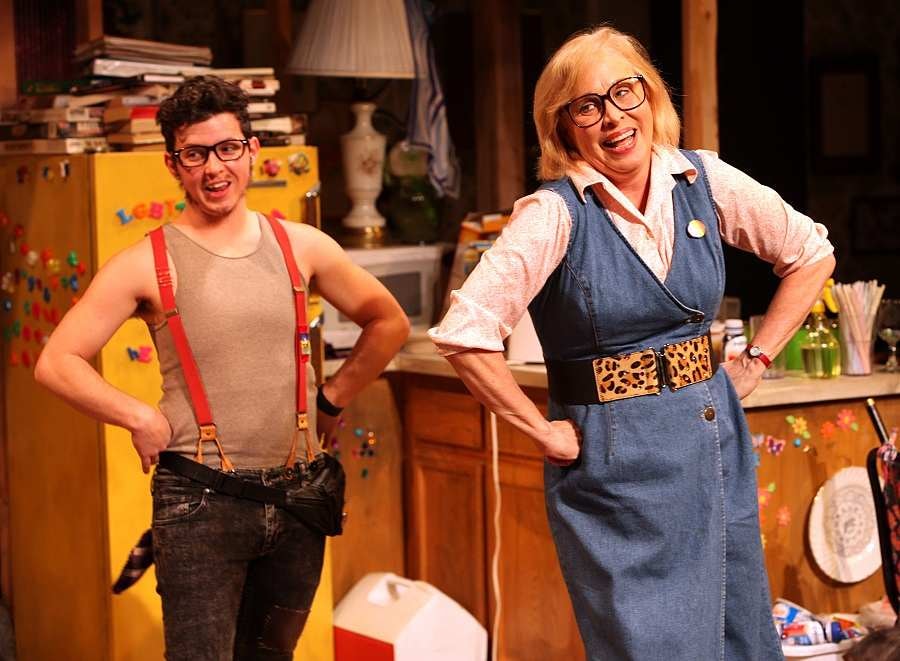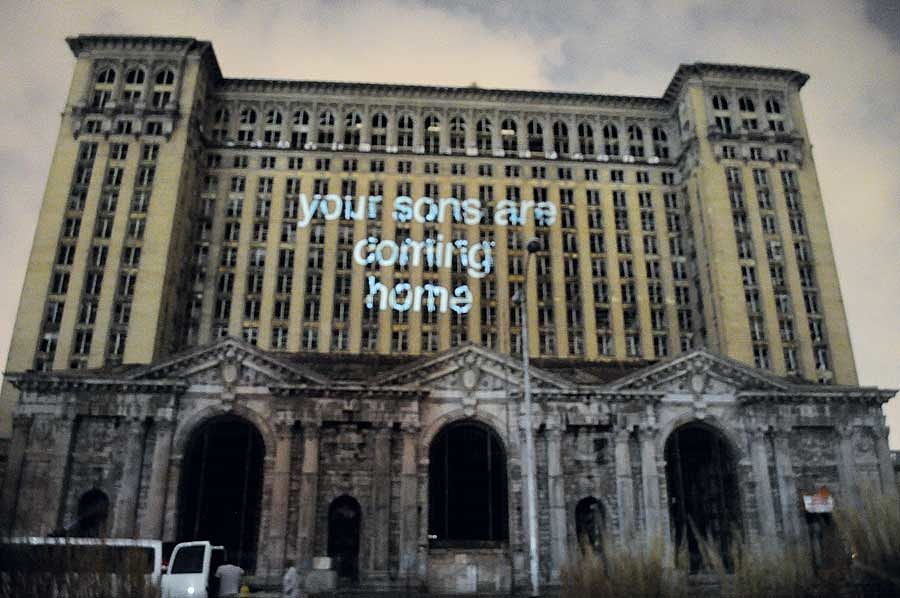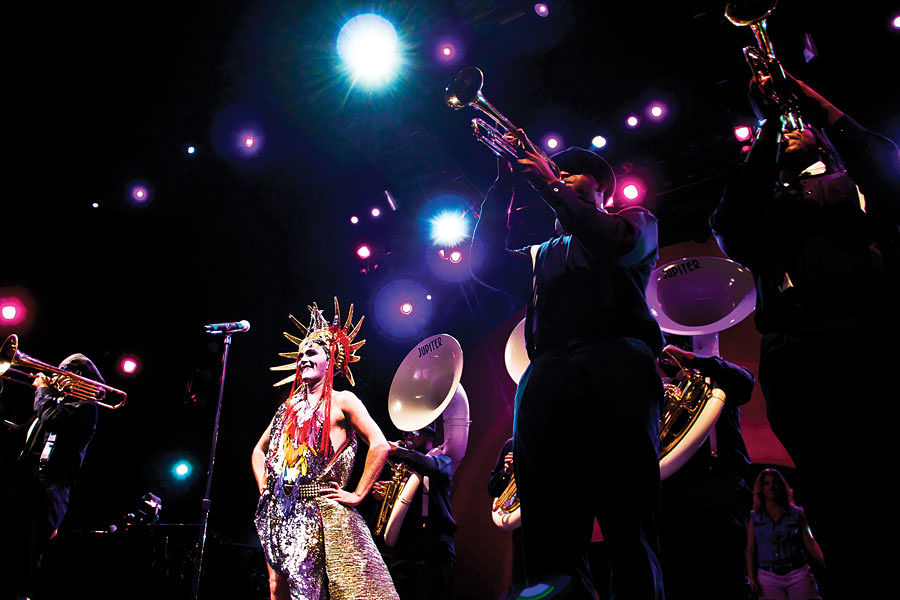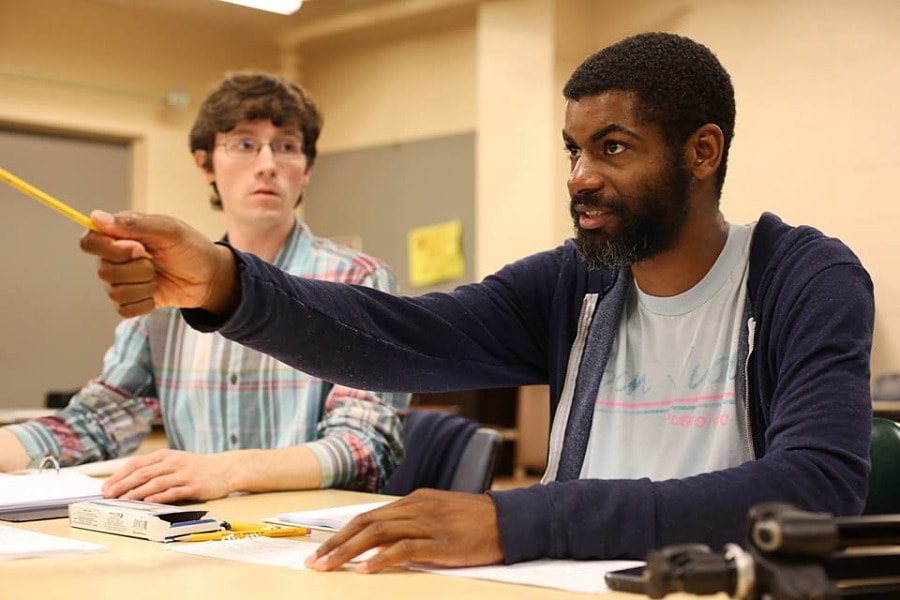While his parents worked in a local cotton mill, five-year-old Niegel Smith would walk two miles from his home with his great-great-grandmother, the granddaughter of slaves, to a grassy hill at the center of his hometown of Albemarle, N.C., a town with two stoplights. Together, they would pick up the latest allotment of government cheese, powdered milk, powdered eggs, and evaporated milk, doled out by government workers from the back of a semi. This was about the same time he appeared in his first Nativity play at the Colston Street Church of God, the one-room white clapboard Pentecostal house of worship that his family attended.
“Church was theatrical,” Smith says in his deep voice with an easy laugh. “Every Sunday, there were shoutings, falling outs, catching the spirit, praise dancing, speaking in tongues.”
Thirty years later, Niegel Smith, is one of the busiest theatre artists in New York. Though he’s worked on Broadway, much of the theatre in which he is involved as director, performer, or creator seems as distant from New York’s commercial theatre district as from the Nativity plays of his childhood.
For the third time, this time for Playwrights Horizons, Smith is directing Taylor Mac’s Hir. The play’s title is the possessive pronoun of choice for the transgender offspring of the family at the center of what Mac labels his exercise in absurd realism. Hir is just one of three Smith/Mac collaborations. Another is A 24-Decade History of Popular Music, segments of which were shown at the Public Theater’s Under the Radar Festival and at New York’s Park Avenue Armory. Smith and Mac will present it all next year in a concert lasting a continuous 24 hours; the audience will be expected to sign a contract to stay the whole 24 hours.
Smith also creates his own performance art, in particular his “Walks,” which resemble walking tours only slightly more than acid trips resemble field trips. He’s done 14 such Walks, commissioned variously by museums, colleges, and theatre festivals. In one, Selfies, the participants walked naked through the basement of the City University of New York Graduate Center. In Monumental Walk, which he staged in both London and New York, he encouraged the participants to talk to public statues and sculptures, and asked them to act out the way they imagined these monuments would move.
On top of all this comes a new responsibility. In May, Smith became artistic director of the Flea Theater, the 19-year-old Off-Off-Broadway theatre cofounded by Jim Simpson and his wife, Sigourney Weaver. In addition to overseeing and programming the company’s season, Smith is also readying the theatre for its move next year to an $18-million performing arts complex, which will house three performance spaces.
“The Flea has made a brilliant choice,” says Public Theater artistic director Oskar Eustis, who was Smith’s first mentor. “Niegel is a unique and remarkable artist.”
“I’m not surprised he got the job, because he’s always the guy that gets the job,” says Todd Shalom, a poet and performance artist who is among Smith’s regular collaborators. “He’s the perfect candidate for a downtown theatre that’s looking to push the boundaries of what they do.”

When Mac first heard the news, he confesses, he had “a little moment of panic—like, Oh, no! What’s going to happen to our collaboration?” But Mac acknowledges that Smith “has some great ideas for what you do with that space. He has already been making it feel more inclusive.”
“I say bravo,” says choreographer and director Bill T. Jones, who hired Smith as associate director on Fela!, both on Broadway and on its tours. “He is highly educated, yet he definitely keeps the memory of being underclass. He told me that when he makes his work, he always thinks about his mother—somebody who is not a sophisticated theatregoer, but somebody he would like very much to reach. I find it very refreshing that she is the audience he has in mind. He and persons like him are the future of American theatre.”
Turning Point in Detroit
Smith’s Walks began under the influence of Shalom, whom he met through a gay website. They went on a date to see Edward Albee’s Seascape, then decided, as Shalom puts it, “We’re better ‘artners’ than partners.” Earlier this year, their 20th piece together, Dream State of Affairs at the Invisible Dog Art Center in Brooklyn, celebrated their 10 years of collaboration by, for example, having audience members read aloud e-mails Smith and Shalom had sent to each other over the years. Shalom is artistic director of Elastic City, where Smith continues as associate artistic director.
Smith and Shalom are also two self-described “ringleaders” of Willing Participant, an organization of activist artists whose mission is to stage “urgent poetic responses to crazy shit that happens,” including the Boston marathon bombing and the killings of Michael Brown in Ferguson, Mo., and Eric Garner in Staten Island, N.Y. After the acquittal of George Zimmerman in Trayvon Martin’s shooting, hoodie-wearing Willing Participant members flooded into Times Square just as Broadway shows were getting out.
Smith was in London a few years ago for the tour of Fela! when he read in the newspaper that the city of Detroit was going through a traumatic time. It suddenly struck him that Detroit’s crisis mirrored a personal trauma he’d experienced himself in that same city. When he was 13 years old, his parents separated and his mother moved him and his two younger brothers from rural North Carolina to Motor City, where her sister lived.
“Detroit was ugly,” Smith recalls. “The houses were burned down. It was the height of the crack epidemic. We lived in my aunt’s basement for eight months, and my mother worked three jobs; I rarely saw her.”
Sitting in London years later, reading about the city’s problems, he hatched his most ambitious Walk to date. After a year of preparation, he “performed” Total Detroit, leading a dozen people from New York to Detroit over three days and two nights. It began at the airport before the flight from New York, because, he says, “I wanted the group first to feel like outsiders, because that’s how I felt my whole life.” He made special bags for each participant, asking them to consider what baggage they carry. Both walking extensively and riding around in a rented van, the group visited ruins, volunteered at an urban farm to feed the hungry, projected words onto an abandoned building (“Don’t Give In”), and engaged in impromptu rituals, as well as a song and dance when they found a piano on the street.

Smith also brought them to the white-framed house where he lived with his mother and brothers and where, he told them, his mother’s boyfriend had sexually abused him. Then he asked them to share their own traumatic events, if they wished. Afterwards, Smith remembers, “We lit candles and stayed on the sidewalk until the candles burned away.”
For Smith, Detroit is more than just the site of personal drama. He says he doubts he’d be a theatre artist at all if he’d stayed in North Carolina. In Detroit, his mother saved up enough to send him to an elite Catholic school, which required an entrance examination.
“School was my saving grace,” Smith says. The school had an active theatre program, and at 14, he got a part in The Sound of Music. At age 17, while in the cast of Oklahoma!, Smith looked at the director, the English teacher MerrieGay Ayrault, with envy.
“Performing is fun; you get to pretend,” he said to himself. “But I thought I could be a director. I had a vision for how to put things in front of an audience.” At his request, the teacher made him her assistant in the next production, Arsenic and Old Lace.
In her English class, she also assigned The Zoo Story. Entranced, Smith read all of Albee’s plays on his own. When it came time to choose a college— he had done well enough in school academically to attract Ivy League interest—he chose Dartmouth, which offered him significant financial aid, and “was as far from a city as I could pick.”
In his freshman year, he decided he would make a career in the theatre; by sophomore year, he realized, as he puts it, “I wasn’t interested in anything where the audience could sit back and relax.” He was greatly influenced by visiting artists like Guillermo Gómez-Peña, and by professors like Annabelle Winograd, who brought her modern drama class to New York to see Hedwig and the Angry Inch at the Jane Street Theatre. By senior year, he says, “I thought I would be running a theatre like Cornerstone [the Los Angeles–based theatre that makes plays for and with the underserved], but in a rural community.”

Broadway Baby
One of his professors, however, helped him get a yearlong paid internship at Trinity Repertory Company, in Providence, R.I., where Eustis was the artistic director at the time. Though he was an education intern, he asked to attend all rehearsals and he took notes.
Nine months into the internship, Buzz Cohen, a stage manager at Trinity Rep who also worked at New York’s Public Theater, recommended Smith to Public’ artistic director George C. Wolfe, and Wolfe hired Smith to be his assistant on the final workshop of a new musical he was directing by Tony Kushner and Jeanine Tesori. Smith stayed with the show, Caroline, or Change, when it went to a full production and then transferred uptown. At age 24, he was working on Broadway.
He couldn’t hide his ambition—“George Wolfe used to call me Niegel Harrington, after Eve Harrington in All About Eve”—but admits now that he “felt starstruck and sidetracked.” The major lesson he learned from Wolfe, he says, was the necessity of being “populist.”
“He used to say, ‘You’ve got to take them to the party before you throw them to the wolves,’” Smith says. “It’s a brilliant way of thinking about it. I don’t see myself as an entertainer. I use spectacle. I use humor. I use gimmicks. But I use them in order to explore tough questions.”
When Jones hired Smith as Fela!’s associate director, he remembers “him being very warm, self-effacing, with a great sense of humor,” Jones says. “He was a great one for putting systems in place, for organizing rehearsals, and scheduling and providing focus. He is very organized, but he has a poet’s heart.”
Smith spent five years working with the musical about Fela Kuti, the musician and human rights activist.
“What Fela! the musical, Fela the man, and Bill T. Jones taught me was the necessity of using your unique voice as an artist, and not to be afraid of it,” Smith says. “I was afraid of my anger. My dad would say when I was growing up that you have to give them 110 percent so you can’t give white people any reasons not to hire you. I interpreted that as: I couldn’t take risks, I couldn’t be angry.” Jones taught him that “my anger was just as important as my passion, my humility, and my joy.”
Flight to the Flea
Smith worked steadily as a freelance theatre director: at the Public on Branden Jacobs-Jenkins’s incendiary debut Neighbors, about a black family of minstrel performers; at the Classical Theatre of Harlem on Radha Blank’s Seed, about a burned-out social worker and her relationship with a 12-year-old “from the projects”; at HERE Arts Center on Limbs: A Pageant, which he also conceived, about amputee veterans of America’s 20th-century wars; and at theatres around New York and the regions on works by José Rivera, Suzan-Lori Parks, Saviana Stanescu, and more. “I’ve always been an outsider. That’s one of the reasons I thrive in performance art and Off-Off-Broadway,” says Smith. “This is the place for outsiders.”
His background as a director and his commitment to Off-Off-Broadway helped him stand out when he answered an ad in Playbill for a new artistic director for the Flea. Jim Simpson had decided to retire, and planned it so his replacement would have time to learn the ropes before the company moved into its new performing arts complex in the fall of 2016.
“We were looking for someone who was articulate about what was important about the theatre,” says Carol Ostrow, the Flea’s producing director. “Someone who embraced emerging artists, who was committed to diversity, who was smart, and who knew how to direct.”
They got 84 applications and whittled them down to four finalists to interview, one of whom was Smith. “Neither Jim nor I had ever met Niegel,” Ostrow says. “I didn’t know he was black until the first interview.”
They selected him because “he was charismatic, warm, and ready,” adds Ostrow. “He had a clear vision; he had seen our shows; the work he did was groundbreaking. Here was a young director who could have a career on Broadway, but he was choosing to have one Off-Off-Broadway.”

All these qualities won out over their one concern: “He’s untested,” says Ostrow. “He’s never run an institution. Would he have the patience with the nuances and unattractive realities—like when the toilet overflows? Artistic directors need to stay within the budget. Directors just say ‘more, more, more.’”
Smith says his vision for the Flea includes the trademark avant-garde theatre, but also concerts, dance, puppetry—and performance art. His first season features new plays by Thomas Bradshaw and Jennifer Haley, but also his new collaboration with Shalom, Take Care, which he describes as “a participatory performance that investigates the ways we respond to present and imminent danger.” Tapping into the personal and global concerns of the Flea’s young acting company, the Bats, he says they “found a provocative intersection between our nation’s inadequate response to the systemic racism that devalues brown bodies and the ongoing climate change crisis.”
He also hopes to work with Mac on a new work under the wing of the Flea. He even plans to commission artists to make their own Walks for Flea audiences. “The Flea’s a community center,” explains Smith. “But not all that the Flea does will happen inside the Flea Theater.”
“For a piece of theatre to be successful, there has to be a charismatic performer and an interested audience,” Smith says. “That’s all you need.”
One Sunday afternoon, Smith held the monthly meeting of Willing Participant to start mapping out a long-term artistic response to the mass shooting that occurred in June at the Emanuel African Methodist Episcopal Church in downtown Charleston, S.C. The meeting began in the basement space of the Flea and felt more like a poetry writing workshop than a political gathering, with various prompts for exercises that slowly evolved into ideas for memes to create on social media.
At precisely 5 p.m., Smith announced that the group would have to move outside, so as not to disturb the performance in the upstairs theatre. Smith and a dozen other New York artists sat on the sidewalk for at least another half hour. The lifelong outsider was happy to sit outside the theatre he now runs.
New York City–based arts journalist Jonathan Mandell writes regularly for this magazine.


